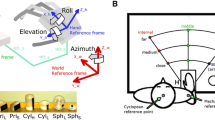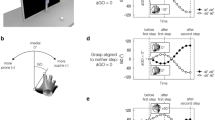Abstract
We investigated the choice of contact points during multidigit grasping of different objects. In Experiment 1, cylinders were grasped and lifted. Participants were either instructed as to the number of fingers they should use, ranging from a two-finger grasp to a five-finger grasp, or could grasp with their preferred number of fingers. We found a strong relationship between the position of the fingertips on the object and the number of fingers used. In general, variability in the choice of contact points was low within- as well as between participants. The virtual finger, defined as the geometric mean position of fingers opposing the thumb, was in almost perfect opposition to the thumb, suggesting the formation of a functional unit using all contributing fingers in the grasp. In Experiment 2, four more complex shapes (rectangle, hexagon, pentagon, curved object) were grasped. Although we found some moderate between-participant variability in the choice of contact points, the within-participant variability was again remarkably low. In both experiments, participants showed a strong preference to use four or five fingers during grasping when left with free choice. Taken together, our findings suggest a preplanning of the grasping movement and that grasping results from a coordinated interplay between the fingers contributing to the grasp that cannot be understood as independent digit movements.









Similar content being viewed by others
References
Ansuini C, Giosa L, Turella L et al (2008) An object for an action, the same object for other actions: effects on hand shaping. Exp Brain Res 185:111–119. doi:10.1007/s00221-007-1136-4
Arbib MA (1990) Programs, schemas, and neural networks for control of hand movements: beyond the RS framework. In: Jeannerod M (ed) Attention and performance XIII: motor representation and control. Erlbaum, Hillsdale, pp 111–137
Arbib MA, Iberall T, Lyons D (1985) Coordinated control programs for movements of the hand. In: Goodman AW, Darian-Smith I (eds) Hand function and the neocortex. Springer, Berlin, pp 137–170
Baud-Bovy G, Soechting JF (2001) Two virtual fingers in the control of the tripod grasp. J Neurophysiol 86:604–615
Bingham GP, Muchisky MM (1993) Center of mass perception and inertial frames of reference. Percept Psychophys 54:617–632
Cesari P, Newell KM (1999) The scaling of human grip configurations. J Exp Psychol Human Percept Perform 25:927–935
Cesari P, Newell KM (2000) Body-scaled transitions in human grip configurations. J Exp Psychol Human Percept Perform 26:1657–1668. doi:10.1037//0096-1523.26.5.1657
Cornell JE, Young DM, Seaman SL, Kirk RE (1992) Power comparisons of eight tests for sphericity in repeated measures designs. J Educ Behav Stat 17:233–249. doi:10.3102/10769986017003233
Crajé C, van der Kamp J, Steenbergen B (2008) The effect of the “rod-and-frame” illusion on grip planning in a sequential object manipulation task. Exp Brain Res 185:53–62. doi:10.1007/s00221-007-1130-x
Crajé C, Lukos JR, Ansuini C et al (2011) The effects of task and content on digit placement on a bottle. Exp Brain Res 212:119–124. doi:10.1007/s00221-011-2704-1
Cuijpers RH, Brenner E, Smeets JBJ (2006) Grasping reveals visual misjudgements of shape. Exp Brain Res 175:32–44
Duemmler T, Schoeberl P, Schwarzer G (2008) Development of visual center of mass localization for grasp point selection. Cogn Dev 23:370–384. doi:10.1016/j.cogdev.2008.06.002
Flanagan JR, Burstedt MK, Johansson RS (1999) Control of fingertip forces in multidigit manipulation. J Neurophysiol 81:1706–1717
Friedman J, Flash T (2007) Task-dependent selection of grasp kinematics and stiffness in human object manipulation. Cortex 43:444–460
Fu Q, Zhang W, Santello M (2010) Anticipatory planning and control of grasp positions and forces for dexterous two-digit manipulation. J Neurosci 30:9117–9126. doi:10.1523/JNEUROSCI.4159-09.2010
Gentilucci M, Caselli L, Secchi C (2003) Finger control in the tripod grasp. Exp Brain Res 149:351–360
Goodale MA, Meenan JP, Bülthoff HH et al (1994) Separate neural pathways for the visual analysis of object shape in perception and prehension. Curr Biol 4:604–610
Hayter AJ (1986) The maximum familywise error rate of Fisher’s least significant difference test. J Am Stat Assoc 81:1000–1004
Hesse C, Deubel H (2010) Advance planning in sequential pick-and-place tasks. J Neurophysiol 104:508–516. doi:10.1152/jn.00097.2010
Iberall T (1987) A neural model of human prehension. University of Massachusetts, Amherst
Iberall T, Bingham GP, Arbib MA (1986) Opposition space as a structuring concept for the analysis of skilled hand movements. In: Heuer H, Fromm C (eds) Generation and modulation of action patterns. Springer, Berlin, pp 158–173
Jeannerod M (1981) Intersegmental coordination during reaching at natural visual objects. In: Long J, Baddeley A (eds) Attention and performance IX. Erlbaum, Hillsdale, pp 153–169
Jeannerod M (1984) The timing of natural prehension movements. J Mot Behav 16:235–254
John S (1971) Some optimal multivariate tests. Biometrika 58:123–127
Kirk RE (1994) Experimental design: procedures for behavioral sciences, 3rd edn. Wadsworth Publishing
Kleinholdermann U, Brenner E, Franz VH, Smeets JBJ (2007) Grasping trapezoidal objects. Exp Brain Res 180:415–420
Kuhtz-Buschbeck JP, Gilster R, Wolff S et al (2008) Brain activity is similar during precision and power gripping with light force: an fMRI study. NeuroImage 40:1469–1481. doi:16/j.neuroimage.2008.01.037
Lederman SJ, Wing AM (2003) Perceptual judgement, grasp point selection and object symmetry. Exp Brain Res 152:156–165
Lukos J, Ansuini C, Santello M (2007) Choice of contact points during multidigit grasping: effect of predictability of object center of mass location. J Neurosci 27:3894–3903. doi:10.1523/JNEUROSCI.4693-06.2007
Lukos JR, Ansuini C, Santello M (2008) Anticipatory control of grasping: independence of sensorimotor memories for kinematics and kinetics. J Neurosci 28:12765
MacKenzie CL, Iberall T (1994) The grasping hand. Elsevier, Amsterdam
Marteniuk RG, Bertram CP (1999) On achieving strong inference in prehension research. Mot Control 3:272–275
Milgram P (1987) A spectacle-mounted liquid-crystal tachistoscope. Behav Res Methods Instrum Comput 19:449–456. doi:10.3758/BF03205613
Napier JR (1956) The prehensile movements of the human Hand. J Bone Joint Surg Br 38:902–913
Newell KM, Cesari P (1999) On taking the grasping out of prehension. Mot Control 3:285–288
Newell KM, Scully DM, Tenenbaum F, Hardiman S (1989) Body scale and the development of prehension. Dev Psychobiol 22:1–13
Newell KM, McDonald PV, Baillargeon R (1993) Body scale and infant grip configurations. Dev Psychobiol 26:195–205
Paulignan Y, MacKenzie C, Marteniuk R, Jeannerod M (1991) Selective perturbation of visual input during prehension movements. 1. The effects of changing object position. Exp Brain Res 83:502–512
Paulignan Y, Frak VG, Toni I, Jeannerod M (1997) Influence of object position and size on human prehension movements. Exp Brain Res 114:226–234
Rosenbaum DA, van Heugten CM, Caldwell GE (1996) From cognition to biomechanics and back: the end-state comfort effect and the middle-is-faster effect. Acta Psychol 94:59–85
Rosenbaum DA, Meulenbroek RJG, Vaughan J, Elsinger C (1999) Approaching grasping from different perspectives. Mot Control 3:289–297
Rosenbaum DA, Meulenbroek RJ, Vaughan J, Jansen C (2001) Posture-based motion planning: applications to grasping. Psychol Rev 108:709–734. doi:10.1037//0033-295X.108.4.709
Santello M, Soechting JF (2000) Force synergies for multifingered grasping. Exp Brain Res 133:457–467
Schot WD, Brenner E, Smeets JBJ (2010) Posture of the arm when grasping spheres to place them elsewhere. Exp Brain Res 204:163–171. doi:10.1007/s00221-010-2261-z
Shim JK, Park JB (2007) Prehension synergies: principle of superposition and hierarchical organization in circular object prehension. Exp Brain Res 180:541–556. doi:10.1007/s00221-007-0872-9
Smeets JBJ, Brenner E (1999) A new view on grasping. Mot Control 3:237–271
Smeets JBJ, Brenner E (2001) Independent movements of the digits in grasping. Exp Brain Res 139:92–100
Steenbergen B (1999) What can be learned from Smeets and Brenner’s model about the control of grasping? Mot Control 3:302–306
van de Kamp C, Zaal FTJM (2007) Prehension is really reaching and grasping. Exp Brain Res 182:27–34. doi:10.1007/s00221-007-0968-2
Wing AM, Lederman SJ (1998) Anticipating load torques produced by voluntary movements. J Exp Psychol Hum Percept Perform 24:1571–1581
Zhang W, Rosenbaum DA (2008) Planning for manual positioning: the end-state comfort effect for manual abduction-adduction. Exp Brain Res 184:383–389. doi:10.1007/s00221-007-1106-x
Acknowledgments
This study was supported by the 7th Framework Program of the European Community (“GRASP,” ICT-215821) and by the Cluster of Excellence “Cognition for Technical Systems” (CoTeSys). We thank Birgitt Aßfalg and Anna Klapetek for help in data collection. We also thank two anonymous reviewers for their thoughtful comments on our study.
Author information
Authors and Affiliations
Corresponding author
Rights and permissions
About this article
Cite this article
Gilster, R., Hesse, C. & Deubel, H. Contact points during multidigit grasping of geometric objects. Exp Brain Res 217, 137–151 (2012). https://doi.org/10.1007/s00221-011-2980-9
Received:
Accepted:
Published:
Issue Date:
DOI: https://doi.org/10.1007/s00221-011-2980-9




